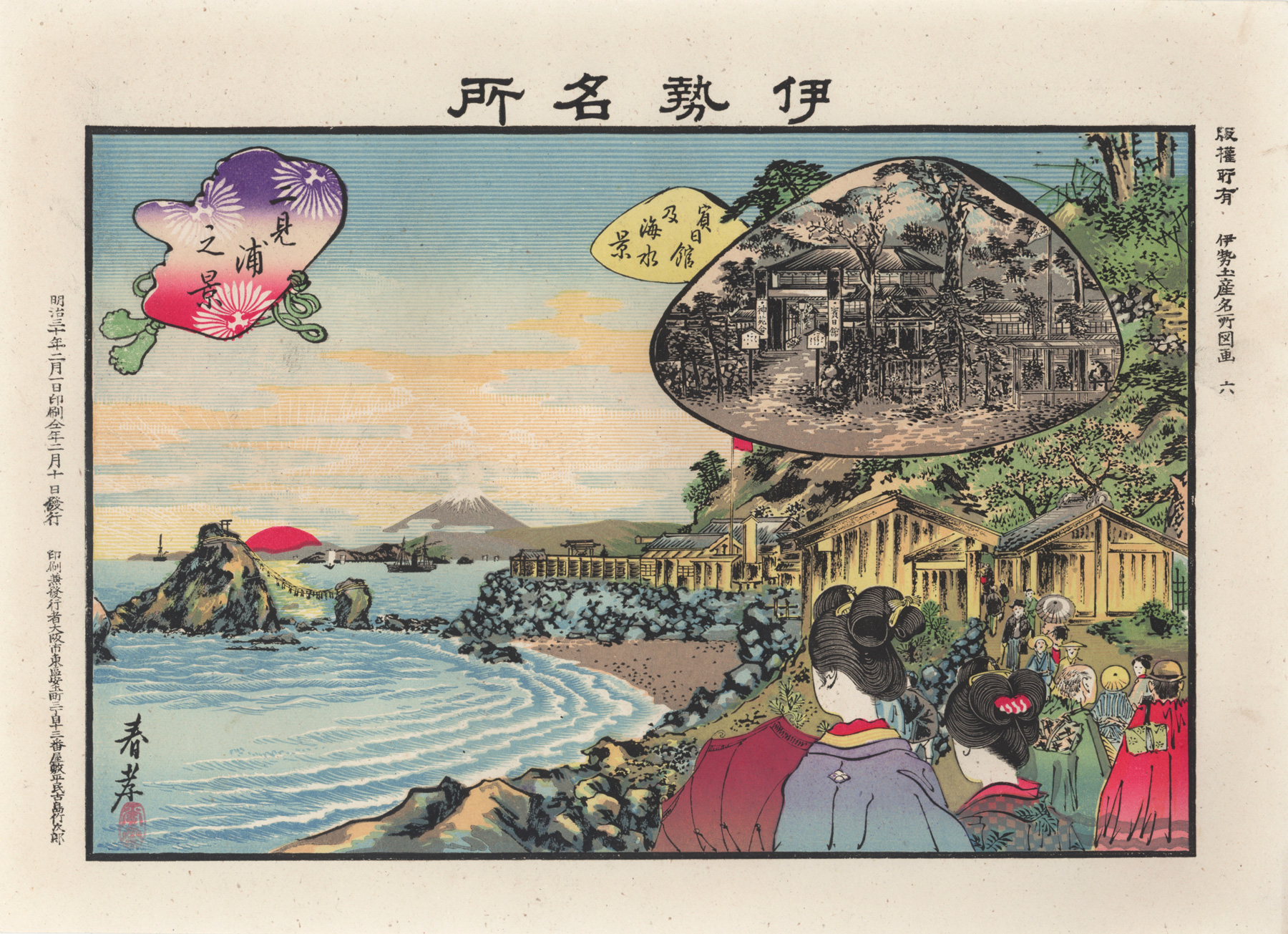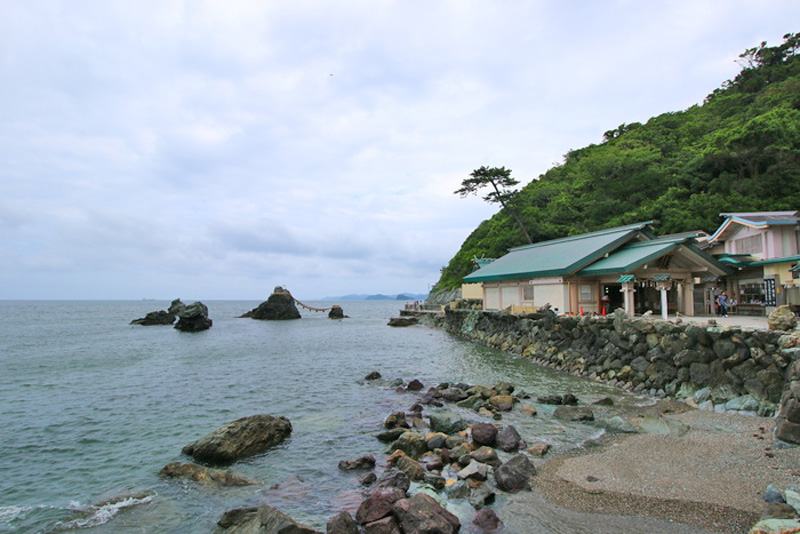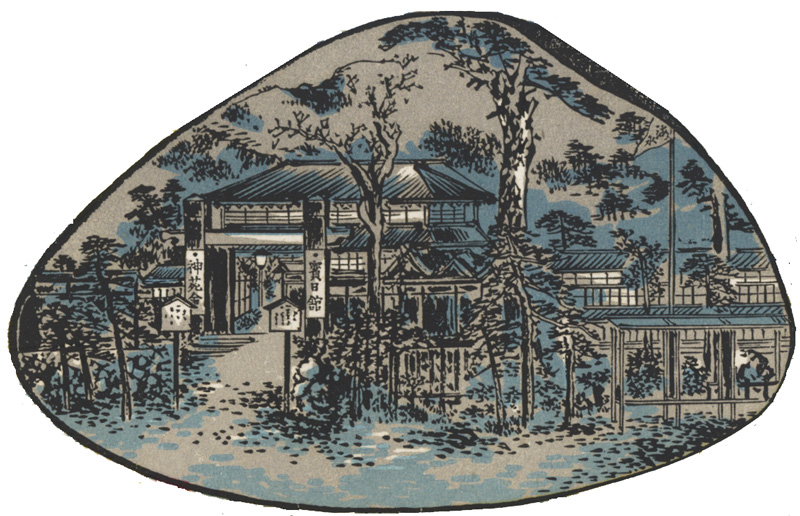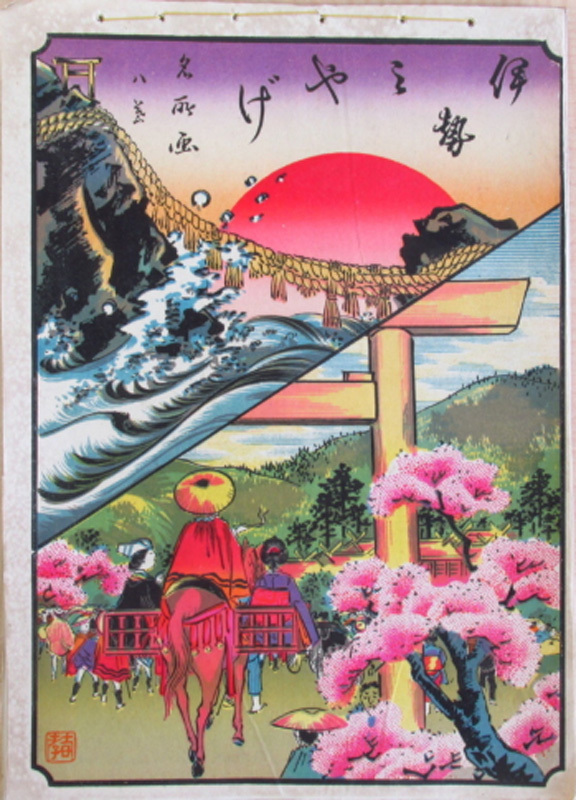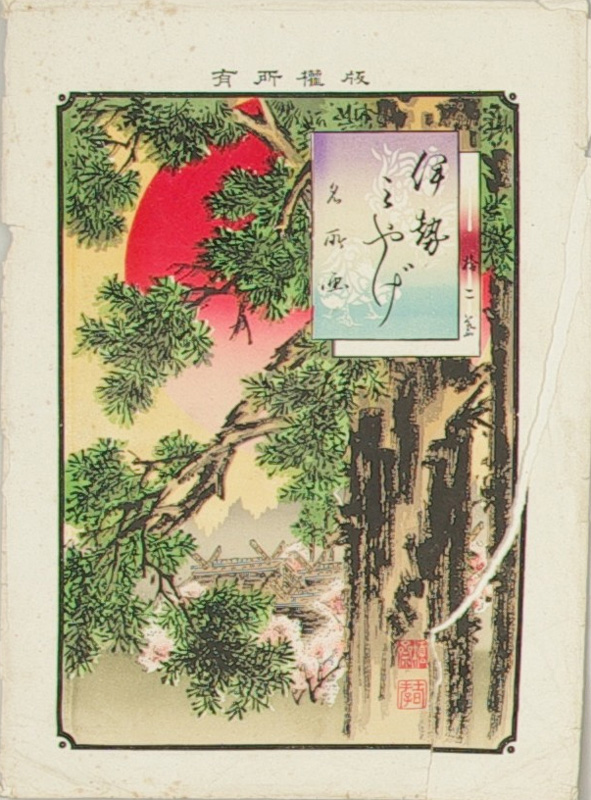About This Print
Two copies of print six (issued two weeks apart) in a set of twelve color lithographs of famous views/places in Ise, an old province in Japan that corresponds to most of modern Mie Prefecture, including Ise City and Ise Shrine. This print depicts pilgrims and visitors viewing the sunrise between the Wedded Rocks (meoto iwa), a natural torii, offshore of Futamigaura in Mie Prefecture. Mt. Fuji is visible in the distance. The buildings on the right are Futami Okitama Shrine, dedicated to the deities Sarutahiko Ōkami and Ukanomitama. Pilgrims often visit this shrine and purify themselves before proceeding to Ise Shrine.Interestingly, the printer has used his discretion, perhaps at the behest of the publisher, in how he printed the insets on the two prints, changing both the coloration and the dappling on the ground, as shown in the inset detail below. While the dates of printing for these two prints, as printed in their left margins (see details below) are the same, February 1, 1897, their release dates are two weeks apart February 10, 1897 for IHL Cat. #2345 and Feburary 25, 1897 for IHL Cat. #2259. The artist seals, see details below, are also different on the two prints and other small differences in the use of color can be seen.
Inset
The inset in the upper right of the print is a night time scene of the famous Hinjitsukan, built as a luxury inn which hosted Emperor Meiji's mother-in-law in March 1887, followed by other royals and the well-healed.
Futamigaura and Futami Okitama Shrine
"[W]orship at these rocks is a rather late development. It is believed that they were not symbolic until sometime in the middle ages when the popular worship of Ise was developing."1
Futami Okitama Shrine is dedicated to the deities Sarutahiko and Ukanomitma.
"In Japan's origin story, Sarutahiko guided Ninigi-no-Mikoto, grandson of the sun goddess Amaterasu, to Earth, where he became grandfather of the nation's first emperor, Jimmu. Ukanomitama, on the other hand, is typically depicted as a goddess associated with food and agriculture.
The shrine is a popular tourist attraction with its numerous frog statues pulling in the crowds with their cuteness. The frogs are a kind of charm for bringing people or things back safely, since in Japanese the term for frog is kaeru, which also means "to return." The shrine is also popular with couples, who visit to pray for luck in love from nearby Meoto Iwa."2
The shrine is a popular tourist attraction with its numerous frog statues pulling in the crowds with their cuteness. The frogs are a kind of charm for bringing people or things back safely, since in Japanese the term for frog is kaeru, which also means "to return." The shrine is also popular with couples, who visit to pray for luck in love from nearby Meoto Iwa."2
Married Rocks and Okitama Shrine
1 "Shinto Symbols" appearing in Contemporary Religions in Japan, Vol. 7, No. 1, Nanzan University, March 1966, p. 24.
2 website of All About Japan https://allabout-japan.com/en/article/3078/
Hinjitsukan and Shin'enkai
Hinjitsukan Today
In this evening scene of Hinjitsukan, two signboards are shown on either side of the entrance to Hijitsukan reading 神苑会 Shin’enkai to the left and 賓日館 Hinjitsukan on the right. Shin'enkai (Sacred Garden Society) was founded in 1886 by Ōta Kosaburō (1845-1916), a tea house owner and founder of the Sangū Railway Company, to improve the area around Ise Shrine.1
Today Hinjitsukan is an Important Cultural Property serving as a museum.
1 website of Ise City Board of Education https://www.city.ise.mie.jp/kyouiku/culture/bunkazai_shiseki/scenic/1009128.html
2 website of japan-guide.com https://www.japan-guide.com/e/e4312.html
About The Set "Famous Places in Ise - Souvenir Pictures of Famous Places in Ise"
The publisher, Furushima Takejirō, published twelve prints in February 1897 with the main title "Famous Place of Ise" and the subtitle "Souvenir Pictures of Famous Places in Ise." The entire set of twelve prints was enclosed in a decorative envelope (see below) picturing Ise Jingū's cedar trees and Naikū Shrine, bathed in the glow of the rising sun. This set of prints carries a release date of February 10, 1897. Fifteen days later, on February 25, 1897, prints one through eight only were enclosed in a different decorative envelope (see below) picturing Meoto Iwa (Married-Couple Rocks) at Futamigaura at sunrise along with pilgrims entering the Ise Shrine and released for sale. Both sets were sold to pilgrims in Tsu City and Yamada Town, stop-overs for pilgrims on their way to Ise Jingū.
These prints showed off the latest in color lithography techniques, with many of the prints achieving effects such as bokashi, a gradual gradation of colored ink typically used in woodblock printing.
Map of Sangū Rail Line click on image to enlarge | It has been suggested that this set of prints was issued to promote the upcoming completion of the Sangū tetsudō 参宮鉄道 rail line (Shrine-bound railway) which began operation in 1893, but would only reach Ise Shrine proper (Yamada Station) in November 1897. (Prior to its November completion the rail line ended in Miyagawa, about 8 km from Ise Jingū.) To support this theory, it is pointed out that two of the prints (prints numbered 11 and 12) depict scenes in Tsu City, the starting point for the Sangū, and one print (number 8) depicts Yamada, whose rail station, Yamada Station, the final stop on the Sangū, was to open in November.1 |
On the back of the envelope containing the twelve print set (see image below), are the names of the sales office, Furujima Branch Office in Yamada-Onoechō, Ise Province (a branch of the publisher Takejirō Furujima, who was famous in Osaka at the time), and the distributors Sankyō Limited Liability Company in Yamada-Okamotochō, Ise Province; Hashizume Gohei in Yamada-Uraguchichō, Ise Province; and Ōtake Takesaburō in Tsu-Nishichō, Ise Province.
1 Summarized and translated from the website of Mie Prefectural Museum https://www.bunka.pref.mie.lg.jp/MieMu/82889046576.htm
The Set
| Print Number | Title | Inset Title |
| 1 (壱) | The Sanctuary Aramatsuri-no-miya of Naiku Ise Shrine 天照皇太神宮 内宮 | not applicable |
| 2 (二) | Toyouke Daijingū Shrine 豊受太神宮 外宮 | not applicable |
| 3 (三) | Illustration of Daidai-kagura 大々神楽之図 | Illustration of Kagura Hall 御神楽殿之図 |
| 4 (四) | View of Uji Bridge 宇治橋之景 | Naiku or Main Sanctuary of Ise 内宮神苑正面 |
| 5 (五) | View of Magatama Pond 曲玉池之景 | View of the Main Shrine Garden of Gekū 外宮神苑正面景 |
| 6 (六) | View of Futamigaura 二見浦之景 | View of Hinjitsukan 賓日館及海水景 |
| 7 (七) | Illustration of Furuichi Dance 古市踊之図 | not applicable |
| 8 (八) | Distant View of Yamada Town from Miyagawa Bridge 宮川橋より山田町を望む | not applicable |
| 9 (九) | View of Toyomiyazaki Library 豊宮崎文庫之景 | Agricultural Building 農業舘 |
| 10 (十) | View of Tsukiyomi no miya 月夜見宮之景 | View of Asama dake in Snow 朝熊岳雪景 |
| 11 (十一) | View of Tsu Park [renamed Kairaku Park] 津公園之景 | Kōzan Shrine 高山神社 |
| 12 (十二) | View of Akogi Heiji Monument 阿漕平治塚之景 | View of Karasu Imperial Shinto Shrine 御香良州神社景 |
Print Details
| IHL Catalog | #2258 and #2345 |
| Title (Description) | View of Futamigaura, [print] 6 二見浦之景 [as shown in multicolor title cartouche upper left corner of print] 六 [as printed in right margin] inset: View of Hinjitsukan 賓日館及海水景 [as printed in the yellow cartouche to the left of the inset in the upper right of the print] |
| Series | Famous Places in Ise - Souvenir Pictures of Famous Places in Ise 伊勢名所 [as shown across top of print] 伊勢土産名所図画 [as printed in upper right margin] |
| Artist | Hirose Harutaka (1870-?) |
| Signature |   IHL Cat. #2258 left IHL Cat. #2345 right |
| Seal | 春孝 Harutaka (as shown above) |
| Publication Date |   printed: February 1, 1897 明治三十年二月一日印刷 issued: February 25, 1897 仝二月廿五日発行 IHL Cat. #2345 right: printed: February 1, 1897 明治三十年二月一日印刷 issued: February 10, 1897 仝二月廿五日発行 |
| Publisher |  印刷兼發行者 [printer and publisher] 大阪...[Osaka - address of publisher] 古島竹次郎 [Furushima Takejirō] Source: website of Stategic Management Laboratory Inc. https://sml.co.jp/documents/toppan-ichida.html?page=5 Furushima created both lithographs and woodblock prints and was a member of the Copperplate and Lithography Association of the Osaka Chamber of Commerce which had 27 companies listed as members in 1894. |
| Impression | excellent |
| Colors | excellent |
| Condition | excellent |
| Genre | meisho-e |
| Miscellaneous | color lithograph 色石版画; all rights reserved 版權所有 printed in upper right margin |
| Format | chuban |
| H x W Paper | 7 3/8 x 10 1/16 in. (18.7 x 25.6 cm) |
| H x W Image | 5 3/4 x 8 5/8 (14.6 x 21.9 cm) |
| Literature | |
| Collections This Print | ARC Ukiyo-e Portal Database (National Museum of Japanese History) H-22-1-30-10-8; National Museum of Japanese History https://khirin-a.rekihaku.ac.jp/nmjh_nishikie/h-22-1-30-10-8; Mie Prefectural Library [entire 12 print set] https://www.bunka.pref.mie.lg.jp/viewer/history/00011/book_swf.htm |
7/19/2020 created



